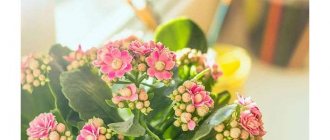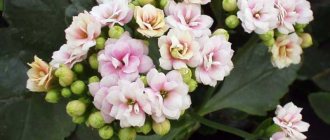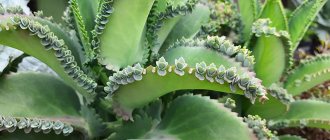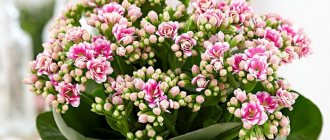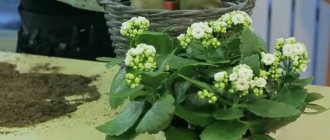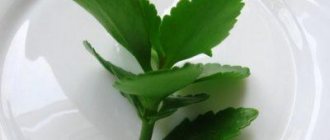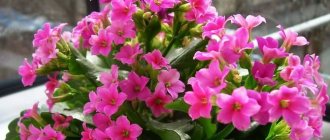Caring for and propagating Kalanchoe at home is quite simple. Kalanchoe is a perennial plant of the Crassulaceae family. In total, there are more than two hundred species in the genus. The places where the flower lives are Australia, Asia and America.
How to grow homemade ginseng - Kalanchoe Degremona plant - in the house? Varieties of Kalanchoe are found in nature. And of course, we pay attention to Kalanchoe with flowers when we are in flower shops. But at the same time, we don’t pay any attention to the unattractive, modest plant. This plant is called Kalanchoe Degremona.
Many diseases can be cured with the help of this plant. If you are concerned about diseases of the internal organs, then it is best to take various decoctions and infusions. If you have a cold or a runny nose, try putting a few drops of Kalanchoe juice into your nose. This plant also has wide possibilities for use. Ointments for external use are also prepared from Kalanchoe.
Reproduction of Kalanchoe by “children”
Along the edges of Kalanchoe leaves there are small shoots - the so-called “babies”. You need to take tweezers and carefully remove the shoots. And when fully ripe, the “babies” fall off on their own.
Next you need to prepare a plastic container. Fill it with soil and water it with water. Then, using tweezers, carefully lay out the “babies” on the surface of the soil. Do not bury, but lightly press down. The distance between the seeds should be approximately 3 cm. Watering should only be done with a spray bottle. It is enough to wet the soil to a depth of 0.5 cm. Then close the container with glass. After two days, lightly moisten the soil with a spray bottle again. Water every other day until the first shoots appear.
The most popular types of Kalanchoe
Today there are about 200 species of Kalanchoe. Among this diversity there are varieties that are completely different from each other. It can be difficult to even imagine that they are relatives. Kalanchoe dissectum, called staghorn, looks like carrot tops with flowers. The Bejar variety resembles miniature burdocks, while Mangina has long drooping stems with bell-shaped flowers at the ends.
But the most popular varieties of this flower are the following:
Kalanchoe Degremona . Herbaceous plant up to 50 cm tall. It has oblong fleshy leaves, along the edges of which small children are formed. They already have aerial roots, and once on the ground, such individuals quickly take root.
Kalanchoe Blossfeld . An unpretentious compact plant with oval carved leaves and many inflorescences of the brightest colors. It stands out for its abundant and long flowering up to 2.5 months.
Kalanchoe Kalandiva . This is the name of one of the varieties of the previous type. You will not find such a plant in the wild; it was obtained by breeders. During flowering, a small bush is literally covered with open buds. Blooms long and profusely. Moreover, this period can also be extended due to additional lighting. In the literature there is also a name for this species: Kalanchoe mix or mini.
Despite such diversity, all representatives of this family are easy to care for; you just need to water, feed and replant correctly.
Care and propagation of Kalanchoe by cuttings
The cutting is prepared by cutting the flower in the middle (see photo). Then we cut off the lower leaves. After the place where the cutting is cut has dried, it needs to be treated with root. Then take a pot with pre-prepared soil and plant the cutting in the hole. Rooting occurs within 8-12 days. Don't forget to moisten the soil with a spray bottle.
What you need to propagate Kalanchoe by cuttings
Kalanchoe tolerates pruning well, and most of its cuttings take root successfully.
To make cuttings as painless a process as possible for the mother plant and the younger generation, it doesn’t hurt to check if you have everything you need to carry out the procedure:
- a sharp knife with a thin blade;
- crushed charcoal;
— root formation stimulator;
- soil for cacti or succulents.
As you can see, propagation of Kalanchoe by cuttings does not require particularly complex preparation. Now take a pot with a plant and carefully examine the shoots.
How to grow Kalanchoe
The plant needs to be watered every day in summer, provided the pot is large. Plants in small pots need to be watered every other day. It would be enough. It is advisable to water as the soil dries. In winter, Kalanchoe should be watered no more than once a week. This plant is a succulent, so it can live without moisture for a long time.
How to adapt a flower to home conditions
After purchase, we send the Kalanchoe to quarantine. Temporary isolation of a flower will give it the opportunity to more easily endure stress and quickly adapt to new conditions. During this period, it is possible to identify the presence of diseases and pests that were previously undetected. This will help protect other house plants from infection.
Usually the sanitary period for a flower lasts two weeks. During this time, it is advisable to keep the Kalanchoe in a separate room, isolated from other domestic vegetation. It is worth choosing a bright place, it is better if it is a window sill on the east or west side of the house, where there is no direct rays of the sun.
Watering during quarantine is moderate. To do this, take settled water at room temperature. Water the flower as the earthen ball dries out. Excess liquid that appears in the trays must be drained. The root system of Kalanchoe is delicate and does not like stagnation of water in the soil. During adaptation at home, fertilizing is not applied to the soil. Purchased plants receive a large amount of useful substances during transportation and storage.
Top dressing
Kalanchoe is not picky. If you need to grow a large amount of material for treatment, then you can feed it with nitroammophoska.
Kalanchoe loves light, but is not afraid of the sun either. Therefore, you can safely place the flower on the windowsill on the sunny side.
Transfer
Kalanchoe still loves a cramped pot. The plant does not take root well in large pots. Therefore, the flower needs to be replanted as the roots grow.
Temperature
Kalanchoe is native to the desert, so this plant is very heat-loving. And the temperature regime must be maintained in accordance with the hot climate. The optimal temperature for Kalanchoe is from +20 to +28 degrees. At temperatures below +10, the Kalanchoe flower begins to freeze. At zero temperature, or at -1 degrees, the plant freezes.
Proper care and cultivation of Kalanchoe will delight gardeners with good growth. Homemade ginseng will help get rid of many diseases and bring many benefits.
Propagation by leaves: how can this be done?
This method is convenient because you can use not only freshly picked leaves for propagation, but also fallen ones. The main thing is that they have a beautiful shape and are large in size. It is advisable to do this in the summer, when all the necessary conditions are available for rooting of the leaves, but, if necessary, the operation can be carried out at any time of the year.
To plant a leaf, you need to take sand into a container, moisten it and bury the leaf with the root down. Cover the top of the sheet with a jar and leave for 2-3 weeks. During this time, a root system will appear on the planted leaves. Now all that remains is to transplant the young plants into individual containers. Care is performed in the same way as with other types of reproduction.
If the Kalanchoe is beautifully formed and you don’t want to cut off a leaf from it, you can use leaf plates buried in the soil for rooting. They will develop in the same way as those cut from the shoots.
Watering
It was already mentioned above that the roots of Kalanchoe rot from excess moisture. How to avoid this? Much depends on the ambient temperature. It is usually advised to water this flower once every ten days. To avoid mistakes, you should always check the earthen ball for moisture. If the top layer of soil is a little wet, it means it is too early to water. Many people are afraid that the plant will dry out, but in fact such fears are unfounded. Since Kalanchoe is from the Crassulaceae family, it has rather plump leaves that store moisture for future use. For this reason, such flowers tolerate drought well.
To properly water, you will need a medical bulb or a special watering can with a spout, without a sprayer. Water must be poured directly onto the soil, bypassing the plant itself. If you have a tray for irrigation and excess water has leaked into it, then it must be drained. A short stay of the pot in a pan of water is allowed. This plant does not like spraying or bathing; if the leaves are a little dusty, they can be wiped with a damp cloth. In case of heavy dust, short-term swimming is allowed. After this procedure, it is important to place the flower in a dry room, avoiding direct sunlight until it dries completely.
Buy and grow?
Many people do not want to wait and prefer to buy a plant that is already flowering.
In principle, this option is not bad if you are sure that it is not in the last phase of flowering. Otherwise, you will end up with a depleted Kalanchoe that needs a period of rest. Ideally, you need to purchase a flower that has just put out its buds, then for about eight months you will be able to enjoy lush and bright flowers.
There are those who themselves know how to grow Kalanchoe. Therefore, they prefer to take a shoot or leaf from their friends. Since the plant reproduces very easily, takes root well and quickly reaches impressive sizes, anyone can grow Kalanchoe at home. How to do it? We will look at several options. Each of them has its pros and cons. Therefore, a person must weigh the pros and cons before starting to propagate a plant.
All methods of reproduction according to complexity
Vegetative methods of propagation of Kalanchoe are not too complicated and labor-intensive. The most common method of propagating Kalanchoe at home, which allows you to quickly obtain an adult plant, is by cuttings.
Kalanchoe cuttings root without any problems. During spring pruning, they are harvested in large quantities. From a large overgrown bush you can get 10-15 young specimens, and in some cases more.
It is also easy to propagate Kalanchoe by offspring. Offshoots are the same cuttings, but already rooted in the soil near the mother plant. From them you can quickly get adult specimens. The only difficulty is that not all plants produce suckers. If they are formed, it is rare and in small quantities, so this method is less productive than cuttings.
Reproduction by children is more labor-intensive than cuttings. The children are already small plants with roots. But to get a medium-sized plant from a child, you need to spend at least 2 years. Kalanchoe is propagated in this way when it is necessary to obtain a large number of young plants.
Growing a plant from a leaf is labor-intensive similar to growing Kalanchoe from babies. Usually, leaf blades of those species that do not produce children are rooted. A very small plant grows from the leaf, which will take considerable time to grow green mass.
And of course, the most difficult and time-consuming process is growing from seeds. It is usually not used in indoor culture, since there are other, much simpler and faster ways to propagate Kalanchoe.
How to choose the right soil?
Store-bought substrates designed for succulents are perfect for replanting.
You can also use soil for flower plants, diluting it with sand in a ratio of four to one. Suitable proportions for the soil are 4 parts peat, 2 parts turf soil and 1 part river sand. The pot for transplanting is taken two centimeters wider than the previous one. Drainage is laid at ¼ of its height, then a layer of soil of about 2-3 cm is poured and compacted. The flower is held in the center and the remaining soil is added, not reaching the edge two centimeters. Finally, lightly moisten the soil.
Mandatory replanting is also required when purchasing Kalanchoe. For sale, the flower is placed in a mixture of peat and coconut fiber, which is unsuitable for cultivation. If the plant does not bloom, it can be replanted immediately. In such cases, after the drainage layer, fill 2/3 of the pot’s volume with soil, and after placing the flower, add another 3 centimeters of soil.
Repotting a plant while it is in bloom is not recommended as this can cause stress and will require long-term care to recover. The exception is transplantation after purchase
In this case, the flower is transferred carefully using the transshipment method. The replanting procedure is almost the same, but after the drainage layer you can add a small amount of sand, and only then soil
If you want to get an exotic type of Kalanchoe that is rarely on sale, you can use seed propagation. To sow them, it is necessary to make sandy-peaty soil. When planting, the seeds are slightly pressed into the ground and covered with glass or polyethylene, which are removed after germination.
How to replant Kalanchoe: a detailed plan for planting in soil or another pot
Plant replanting is required to improve its nutrition and air supply to the root system. This is also necessary in cases of various diseases and if it is necessary to divide the bush.
When choosing soil there are several options:
- Use a mixture for flower plants, having previously diluted it by 25% with coarse sand;
- Use ready-made soil for succulents;
- Make your own mixture of coarse sand, humus and garden soil in equal proportions.
Kalanchoe does not like acidic soil, so we recommend adding lime to the prepared soil.
Kalanchoe seeds
to reduce soil acidity. In any case, at the bottom of the pot there should be a good drainage layer made of expanded clay and clay shards, allowing excellent passage of water and air, which is not toxic.
It is desirable that the new pot be slightly larger than the previous one, by 2-3 cm. Before use, a new pot, especially if it has already been used before, must be scalded with boiling water and treated with a solution of potassium permanganate. This is necessary to destroy all kinds of pests.
The sequence of actions during transplantation is as follows:
- Prepare a new pot with a layer of drainage placed on the bottom, about a quarter of the height of the pot.
- Remove the plant from the old pot and first water it generously. Tilting the pot to one side and lightly tapping the sides, pull the pot until the soil-root ball is released.
- Carefully inspect the root system for diseases and pests. If necessary, trim off rotten parts.
- Place the plant in the new pot so that the root collar is at soil level. The top edge of the pot should be 2-3 cm above the soil level.
- Fill and compact the soil, water the plant.
- Sprinkle the soil with a layer of small pebbles on top. This will make it much easier for you to further care for the plant, preventing the “babies” from growing uncontrollably.
Some time after transplantation, the plant goes through a period of acclimatization; it requires additional feeding.
Newly planted Kalanchoe sprouts
Transplantation should be distinguished from transshipment. Transshipment is a more gentle procedure, in which the integrity of the soil-root ball is not violated, but only the volume of soil increases. That is why, for plants during the flowering period, when replanting is contraindicated, transshipment can be carried out.
Plant Kalanchoe in your home and you will not be disappointed. It is not difficult to grow and propagate it even in winter. This plant is surprisingly easy to care for, practically not susceptible to disease, reproduces easily and will delight you with abundant flowering for a long time.
- Author: Maria Sukhorukikh
Rate this article:
- 5
- 4
- 3
- 2
- 1
(0 votes, average: 0 out of 5)
Share with your friends!
Ideal soil
The easiest way is to buy ready-made soil for succulents and expanded clay, which you need to use for drainage. Some people add expanded clay directly to the soil before planting the plant. In fact, it is not at all difficult to grow Kalanchoe at home. What care rules need to be followed? One of the important points to remember is that this crop does not like excess moisture. If the soil is watered frequently, the roots of the plant will begin to rot, and eventually it may even die.
If you do not have the opportunity to purchase a ready-made mixture for planting, then you can make it yourself. The main thing is to use soil that is poor in organic matter. You should not collect it from a garden that has recently been fertilized; it is better to dig up soil under a deciduous tree and add a little sand to it. Instead of expanded clay, you can use broken tiles or red brick.
Transplanting into another pot
It is better to choose a ceramic pot, as it does not retain excess moisture
How to choose a pot for transplanting
Initially, to replant the plant, you need to select a container 2 cm larger than the previous one. Choose a ceramic pot - it does not retain excess moisture.
What soil is suitable for Kalanchoe
Ideal proportions for soil: 4 parts peat, 2 parts turf soil and 1 part coarse river sand. In addition, soil for succulents is suitable for planting Kalanchoe. Make sure you have good drainage by using expanded clay or crushed brick.
When is the best time to replant Kalanchoe?
Due to its rapid growth, Kalanchoe, undemanding to care, needs an annual transplant.
It is important to remember: it is better to replant a Kalanchoe bush in the spring after the end of the flowering period
Features of transplantation after purchase
After purchase, the Kalanchoe must be replanted, since for sale it is placed in universal soil, which is unsuitable for such plants. Replanting should be done immediately, unless the plant is in bloom. You should remove the Kalanchoe from the pot and carefully shake off the store-bought soil from the roots to completely free them from the “wrong” soil. And only then transplant it into a new substrate.
Kalanchoe must be replanted immediately after purchase.
How can you replant Kalanchoe during flowering?
Repotting causes stress for the plant, especially when the Kalanchoe has put all its energy into flowering. Therefore, it is not recommended to replant a flowering plant.
An exception is the transplantation of Kalanchoe after purchase, when the green doctor is transplanted carefully using the transshipment method, trying to disturb the roots of the plant as little as possible
- Pour water over the soil and tap the pots on the walls so that the soil moves away from the container.
- Prepare a pot into which you will transfer the purchased plant.
- Be sure to place drainage at the bottom of the pot.
- Remove the plant from the pot and transfer it as is to another pot.
Transplantation using the transshipment method is used if the plant is in the flowering stage
In other cases, all manipulations with the flowering bush should be postponed until the end of flowering. Until then, create comfortable temperature conditions for your pet, timely watering and good lighting. The first transplant of Kalanchoe into a wider container is best done in the spring, when flowering ends and the plant begins to gain strength for further development.
How to plant several Kalanchoes that grew in one pot
To plant several plants from one pot in different containers, you should thoroughly shed the soil, carefully remove a lump of soil intertwined with roots from the pot and, unraveling the roots of the Kalanchoe with your fingers, separate the plants from each other. Next, we replant the plants according to the algorithm given below.
General transplant algorithm
Preparing for transplantation:
- We select a suitable container.
- Wash the pot intended for transplanting thoroughly with soap and scald with boiling water.
You need to add drainage to the bottom of the pot before planting.
A layer of soil is added to the pot over the drainage
You need to remove the plant from the pot together with a lump of earth.
What is needed for transplantation?
It is necessary to carefully prepare for plant transplantation. The first thing you need to do is buy all the supplies that may be useful in the process.
- 1pot. The diameter of the new container should be 1-2 cm larger than the size of the old one. Ceramic and plastic products are suitable.
- 2Special land. You can purchase it at a flower shop or prepare it yourself.
- 3Elements for preparing the drainage system. For this purpose, you can use expanded clay and clay shards. In addition, gravel and broken bricks are suitable.
- 4Water. To water Kalanchoe, you can only use settled soft water without lime. The liquid should be boiled in a kettle or allowed to stand.
The pot that will become the new home for the Kalanchoe must first be prepared. It needs to be washed well, preferably with soap, and then wiped dry. Some gardeners prefer to play it safe and, after washing, douse the container with a weak solution of potassium permanganate. This allows you to prevent infection of the plant by dangerous pathogenic microorganisms: fungi and viruses.
It is recommended to keep a flower pot that you have just purchased in a bucket of clean water for 24 hours. This will remove all dirt, dust, crumbs and other unwanted elements from its surface. In addition, prolonged soaking helps remove gases from the ceramic container that remain in the pores after firing. They can harm the plant, which is already weakened after transplantation.


